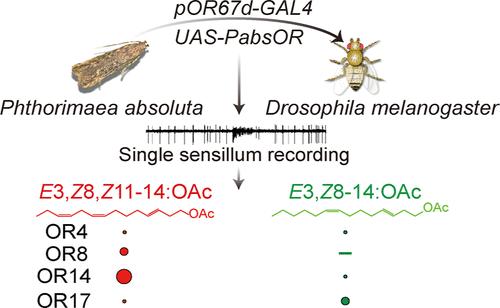番茄潜叶蝇(Phthorimaea absoluta (Meyrick) )性信息素的外围编码
IF 5.7
1区 农林科学
Q1 AGRICULTURE, MULTIDISCIPLINARY
引用次数: 0
摘要
绝对蚜虫会释放(E3,Z8,Z11)-十四碳-3,8,11-三烯醋酸酯(E3,Z8,Z11-14:OAc)和(E3,Z8)-十四碳-3,8-二烯醋酸酯(E3,Z8-14:OAc)作为性信息素,两者的比例为 90:10。然而,这种害虫如何利用信息素受体(PRs)来检测这两种信息素成分尚不清楚。在这里,我们从功能上描述了 P. absoluta 的信息素受体。首先,我们通过转录组测序确定了五个推定的 PR,即 PabsOR4、PabsOR8、PabsOR12a、PabsOR14 和 PabsOR17。这些受体主要在雄性触角中表达。接下来,我们在果蝇 OR67 神经元中表达了这些受体,并研究了它们的反应。PabsOR14和PabsOR8对主要成分E3,Z8,Z11-14:OAc的敏感性不同,而PabsOR17则对次要成分E3,Z8-14:OAc敏感。此外,PabsOR4 对两种性信息素成分的反应都很微弱。此外,PabsOR17 和 PabsOR4 对一种非性信息素化合物--(Z)-7-十二烯基乙酸酯(Z7-12:OAc)有强烈反应。最后,我们证明 Z7-12:OAc 可以替代 E3,Z8-14:OAc 来吸引处女雄性。我们的研究结果阐明了绝对拟尾柱虫性信息素的外围编码,为控制它提供了一个新的视角。本文章由计算机程序翻译,如有差异,请以英文原文为准。

Peripheral Coding of Sex Pheromones in the Tomato Leaf Miner, Phthorimaea absoluta (Meyrick)
Phthorimaea absoluta releases (E3,Z8,Z11)-tetradeca-3,8,11-trienyl acetate (E3,Z8,Z11–14:OAc) and (E3,Z8)-tetradeca-3,8-dienyl acetate (E3,Z8–14:OAc) with a ratio of 90:10 as the sex pheromone. However, how this pest uses pheromone receptors (PRs) to detect the two pheromone components is unknown. Here, we functionally characterize the PR repertoire of P. absoluta. First, we identified five putative PRs by transcriptome sequencing, i.e., PabsOR4, PabsOR8, PabsOR12a, PabsOR14, and PabsOR17. These receptors are predominantly expressed in the male antennae. Next, we expressed them in Drosophila OR67 neurons and investigated their responses. PabsOR14 and PabsOR8 selpond to the main component,E3,Z8,Z11–14:OAc with different sensitivities, while PabsOR17 is tuned to the minor component, E3,Z8–14:OAc. In addition, PabsOR4 weakly responds to both sex pheromone components. Moreover, PabsOR17 and PabsOR4 potently respond to a non-sex pheromone compound, (Z)-7-dodecenyl acetate (Z7–12:OAc). Lastly, we demonstrated that Z7–12:OAc can replace E3,Z8–14:OAc to attract virgin males. Our findings elucidate the peripheral coding of the sex pheromone in P. absoluta, providing a new perspective for controlling it.
求助全文
通过发布文献求助,成功后即可免费获取论文全文。
去求助
来源期刊
CiteScore
9.90
自引率
8.20%
发文量
1375
审稿时长
2.3 months
期刊介绍:
The Journal of Agricultural and Food Chemistry publishes high-quality, cutting edge original research representing complete studies and research advances dealing with the chemistry and biochemistry of agriculture and food. The Journal also encourages papers with chemistry and/or biochemistry as a major component combined with biological/sensory/nutritional/toxicological evaluation related to agriculture and/or food.

 求助内容:
求助内容: 应助结果提醒方式:
应助结果提醒方式:


